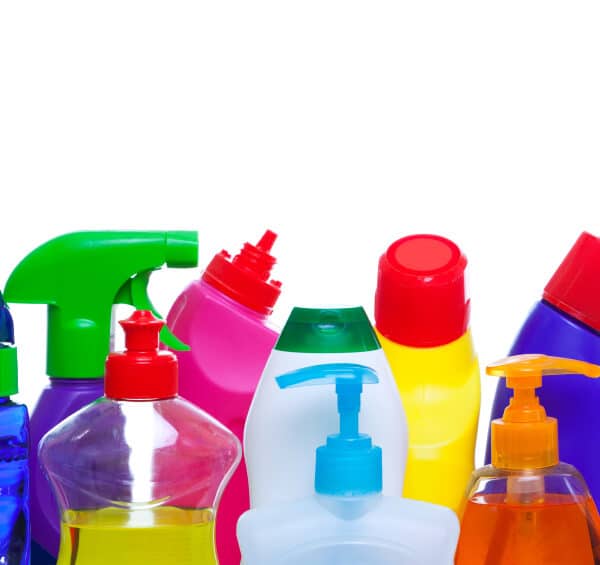 The Control of Substances Hazardous to Health Regulations 2002
The Control of Substances Hazardous to Health Regulations 2002
Every day we all use cleaning products and other hazardous substances that have the potential to damage our heath. In the home environment most people generally keep a variety of cleaning products under the kitchen sink. Cleaning products are common, and every week it is likely that every adult has cleaned something, whether it was the toilet, the mirror, the floor or the washing up.
Although the term COSHH when used within the workplace is associated with working with large amounts of chemicals, it also covers small amounts that are used every day. Cleaning products can easily become hidden hazards as people can be complacent about their risk due to using them in their own home; most people do not link a spray of window cleaner or a toilet cleaner with the term ‘hazardous substance’. On the side of every cleaning product are symbols and information which may show the product to be corrosive, with the potential to cause skin burns and eye damage. Skin allergies and asthma can be caused by some ingredients in cleaning products. In addition, contact with many chemicals can lead to skin soreness and itching, rashes and blistering (dermatitis).
Good practices in the work environment to minimise risk
The work environment needs to have a list of all hazardous products being used on the premises. The material safety data sheet needs to be obtained. A competent person needs to undertake a COSHH risk assessment to understand the risks is and the controls required for each product used on the premises. The QCS site has a COSHH risk assessment for a competent person to risk assess each cleaning product.
Storage of cleaning products
Access to cleaning products on the premises should be restricted. Ensure that only trained workers have access to stored chemical products. Keep all cleaning products in an area where there is no access to vulnerable persons. Ensure that cleaning products are stored in a ventilated, securely locked area which is not near sources of heat. Keep the store area well ventilated; 5-10 air changes per hour with a through draught. Cleaning products that need to be kept apart are:
- flammable and non-flammable liquids
- solid and liquid products
- wastes
- acids and alkalis
Forms of cleaning products
Consideration needs to be given to the safest form of a chemical. Solid chemicals in tablet form, or in a wide-necked container so that it is easy to scoop out granules is better than a liquid which could dribble after pouring. It is important to remember never to store chemicals in open containers. As good practice chemical products should never be decanted into smaller containers that are not labelled or suitable for use.
Safety labelling
Ensure there is suitable safety labelling on the door to the store and that materials safety data sheets are available.
Stocktaking
Monitor the amount of cleaning product used on a weekly basis and only store within the premises what is required. It may be better to keep stock in an outbuilding for topping up the store if stock becomes low.
Hand washing facilities
Good hygiene is important after using any cleaning products. Chemicals can be absorbed through the skin into the body and the hands are one area where this may happen. The business should ensure that good washing facilities are available for workers who are working with cleaning products. Personnel should wash their hands after using chemicals, and before and after eating, drinking, smoking and using the lavatory. Hands should never be cleaned with concentrated cleaning products or solvents.
Personal Protective Equipment (PPE)
The material safety data sheet and the COSHH risk assessment completed by the business will have the details of the personal protective equipment to be worn when using any cleaning products. Cleaning products, such as sprays, can enter the body by inhalation. Masks should be work to prevent this from occurring. Gloves worn when using the cleaning product will help prevent the absorption of chemicals through the skin. A disposable apron is a barrier against splashes or spillages. Eye protection will prevent cleaning products splashing into the eyes. Each cleaning product used may have different requirements for the type of PPE to be used.
Spillage
The business should review what is required for the clean up of a significant spillage. The material safety data sheet will contain the information for each product. Assess whether a spill clean up kit should be located nearby, with personal protective equipment to be used solely for the clean up.
Instruction, information, training and supervision
All staff who use cleaning products should attend a COSHH awareness session to understand the hazards and risks involved. The use of appropriate PPE should also be covered.
Approved suppliers list
Senior Management should review which cleaning products are to be used on the premises and place the suppliers’ details on the approved suppliers list. There are cleaning products that are less hazardous than others and, in addition, are better for the environment.
QCS Policies
QCS has COSHH risk assessment guidance and policies to support your service in meeting the requirements of the Control of Substances Hazardous to Health Regulations 2002.
Further information of The Control of Substances Hazardous to Health Regulations






